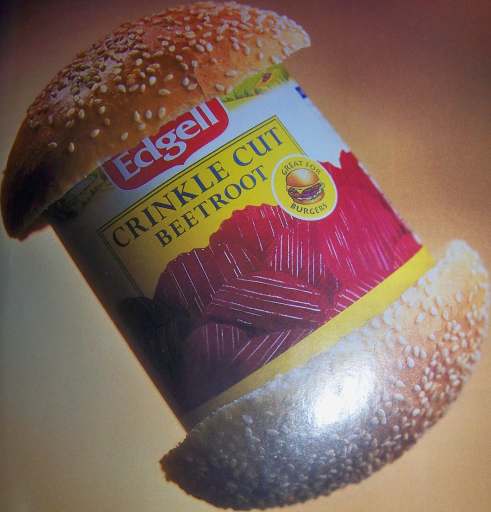
The people who made the above magazine advert gave it two top-halves to the burger bun. But I think that there is actually a demand for such buns, and that it is possible to make them!
Traditional buns have a flat bottom where they rest on a baking tray. One solution to this problem would be to bake in outer space, another possible solution would be to develop a rapid baking process that allows baking in a free-fall aeroplane, but both of these would be unreasonably expensive.
It seems that it would be viable to bake double-ended buns by having a rapidly rising column of hot air to suspend the bun. The terminal velocity of a bun would probably not be that high (maybe 60Km/h) and it should be quite easy to have a pipe full of hot air that bakes the buns. As slight variations in the density and shape of the bun would affect the air-flow it would be necessary to closely monitor the process and adjust the air speed to keep the bun afloat. Manufacturing cheap ovens that use LASERs to monitor the position of the bun should not be difficult.
This might blow the sesame seeds off the bun, but this problem may also be solvable through careful design of the bun shape to make it less aerodynamic and by strongly attaching the seeds. I’m not sure how you would do this.

This has already been invented for regular rolls, see http://www1.mdr.de/einfach-genial/5974946.html (sorry, german only). They are using a waved perforated baking sheet.
Deep fry.
It would be a shame for this project to fail at final step. Clearly this is a strong argument in favour of genetically engineering a hybrid between a sesame seed and a heat-resistant glue stick.
Also, that light spot qualifies for Photoshop Diasters….
Baking the bun in an environment with no gravity would surely not work? Gravity is needed so that the bun will rise along an axis; you’d end up with a ball instead of a bun.
Sad fact: Baking two conventional buns and throwing half of each away is probably going to be way cheaper than anything out of a laser-guided oven. :)
I actualy prefer the flat side. More efficient.
http://en.wikipedia.org/wiki/The_Muffin_Tops
Wolf: Thanks for the reference. The Google translation was pretty poor and it didn’t have detailed photos. So I have to wonder about the quality of the result. It should be cheap and easy to implement though.
Aigars: That would make it a donut. But maybe vacuum frying would give something close to a bun.
Tim: Another possibility might be to have a sesame seed with fine hairs that get embedded into the surface of the dough, it’s probably an easier genetic modification.
Jaymz: It’s an example of why the flash is detachable on a professional camera. The paper was glossy and there was no way of photographing it clearly at a reasonable angle without reflection. Cleaning it up with the GIMP wasn’t a good option because I think that the data wasn’t there.
Matthew: In zero G you could spin it to make it stretch (although that probably takes a significant velocity). Another possibility would be to use air jets to force it into shape.
Andreas: Firstly throwing half away is no fun. Secondly there is the problem of stuff slipping out of a bun which was referenced in the advert – they invented crinkle-cut beetroot to stop it slipping (see the big version of the picture for the details). If you don’t entirely cut the bun into two pieces and instead leave a strip of bread joining the halves then it stops things sliding out.
Tzafrir: There are a variety of ways of doing this. You could squash a bun while it’s being cooked. Or of course you could use one of the varieties of flat bread used in Indian, South American, or Mediterranean cooking.
Nate: Thanks. But I have to note that I would eat bottom-half muffins if the price was right…
I’d just like to mention that it would be extremely hard to fill a round bottomed bun & you would have to hold it in your hand the entire time until you finish it…..
Or you can combine Andreas’ comment with Tzafrir’s preference and make regular breads, cut them in half and use the two round pieces for the people that want them so, and the two flat for the others.
helen: That’s trivial to solve. Put it in a bowl while filling it!
Stavros: But as the previously cited Seinfeld episode demonstrates, more people like the top half. Also having the two halves joined together does offer an advantage.
Rotisserie…